The buying of a first drysuit is an experience similar to a first kiss; fear-inducing, thrill-arousing, and – in general – a perilous venture. However, while an ill-delivered first kiss may come with the risk of embarrassment, a poorly selected drysuit comes with an arguably much greater risk, namely the cost to one’s bank account. Though drysuit selection can at times be a minefield of decisions, it is perfectly possible to select the best one for your needs, even without prior dry-diving experience. Despite the multitude of potential options to consider, drysuit selection can be made simple by reading our review on the best drysuits to buy.
In terms of the possible options at play, the first is that of the material of the suit: neoprene versus trilaminate (technically called laminates as bilaminates, trilaminates and quadlaminates are all available on the market). Once this decision has been made, the next is that of the seal material used: the options are neoprene, latex or silicone. Next comes the consideration of built-in neoprene boots versus neoprene socks with accompanying ‘rock boots’. The final important decision is that between a front-entry versus a rear-entry suit. After these decisions are made come the finer details; these range from whether a metal or a plastic zipper is more optimal, all the way through to the option of adding a pee-valve. Hopefully, this article should help elucidate all of these considerations into a more manageable, step-by-step decision-making process.
The Two Deciding Factors
Arguably, there are two primary questions to answer in deciding what drysuit is best suited for you. Once these are clarified, the decision-making process will be simplified and the basic requirements will be established.
1. What type of diving will you do with the drysuit?
2. How often will you dive with the drysuit?
The answers to these questions, as a by-product, will largely determine the price range in which you will be searching (apart from, of course, your personal price limit!).
The Type of Diving
There are essentially three sub-considerations within this question:
Firstly, will the drysuit be used for recreational diving, or technical diving?
If used for technical diving, there are extra considerations to be made. The use of a harness/backplate/wing setup (typical of technical divers though not exclusive to them) requires a drysuit made of durable material, as the webbing of the harness and the metal of the backplate is abrasive. Similarly, if wreck and/or cave diving is in the current or future agenda, then a durable, tear-resistant material will be of top priority. Typically, this calls for a more expensive trilaminate, or a tougher compressed neoprene. On top of this, neoprene suffers buoyancy changes with depth. Therefore, the deeper one intends to venture, the better it may be to do so with trilaminate. However, for divers remaining within the 40 metre range, this is not of concern.
Secondly, the thermal environment in which the drysuit will be used must be considered.
The qualities needed in a drysuit to dive in the Red Sea in winter are quite different from those required to dive in northern Europe in winter, as an example. For drysuit diving in a typically warm country, a thin neoprene or light, breathable trilaminate will suffice. Conversely, for exposure in water temperatures nearing freezing-point, a thicker/more durable material is necessary. Similarly, a drysuit with attachable dry-gloves is a necessity for cold-water diving; this requires a suit with either latex or silicone wrist seals, as dry-glove ring systems, such as the SI Tech ring system, are incompatible with neoprene seals.
Thirdly, is the drysuit for the travelling diver, or the local dive club diver?
If going to be traveled with, weight and size are important considerations. Trilaminate suits are lighter than neoprene suits, and even within the choice of trilaminates, some are much lighter than others, designed specifically with the traveling diver in mind. Similarly, a plastic zipper is lighter and allows for the suit to be rolled up into a smaller size without unnecessary strain on the zipper. Additionally, neoprene socks are far lighter and more flexible than built-in neoprene boots. Socks reduce total weight and allow for easier rolling up without accidental damage.
The Frequency of Use
For the diver planning to use their drysuit once or twice per year, for less than 2-3 months annually, it is not as necessary to spend more on an extra-durable material, especially if used only for recreational, non-demanding diving. However, if it shall be used on a monthly/weekly basis or more, then it is essential to spend extra to ensure the material used is durable and long-lasting (if you don’t spend the extra, prepare to become best friends with Aquaseal!)
Best Drysuits for Scuba Diving Reviewed
#1 – Waterproof D9X (The Traveller)

The Waterproof D9 Breathable is the perfect option for travelling, warm water diver. Weighing in at a mere 2kg, this breathable quadlaminate suit is optimal for the tropical, recreational diver.
Features
- Extremely light-weight (2kg)
- Flexible, plastic zipper
- Telescopic torso and anatomical tapering
- Soft built-in boots
- Protective zipper cover
- Latex seals
- Cost-efficient
Drawbacks
- Not designed for demanding diving e.g. technical, wreck, very cold.
#2 – Santi E. Lite + (The Demanding Diver)
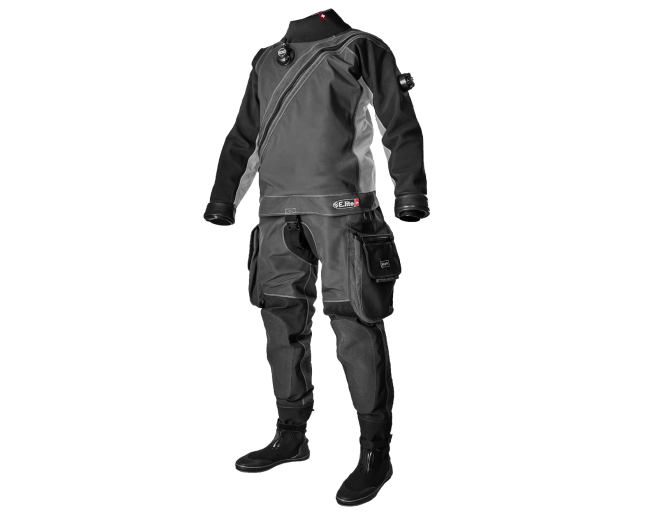
SANTI’s E. Lite is a drysuit designed for the toughest, most demanding conditions, and is, therefore, the best drysuit for technical/wreck/cave divers. SANTI is an industry leader, with their suits used by some of the most advanced, demanding divers worldwide. All suits are available to be made-to-measure, but this – of course – comes at a price.
Features
- Very tough trilaminate with reinforced kevlar knee pads
- SANTI Smart Seals System for quick change silicone seals
- Made to measure option able to customize the suit for your own specific build and measurements
- Plastic zipper
- 2-year warranty
Drawbacks
- Price – for a first time drysuit, with only recreational use in mind, the price may not be worth it as there are much cheaper options
#3 – BARE X-Mission (The Travelling Tec Diver)
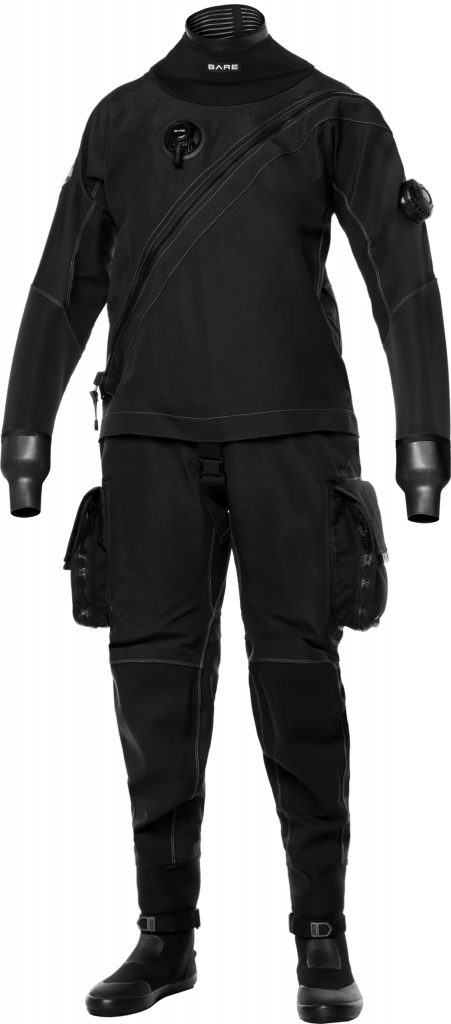
The BARE X-Mission offers the perfect combination of a travel-friendly drysuit combined with a durable trilaminate for the most demanding of conditions. With lightweight Nylon RipStop trilaminate, this drysuit is perfect for the intrepid technical diver.
Features
- Anatomical taper with the telescopic torso
- Extremely flexible Nylon Micro RipStop Trilaminate
- Lightweight but durable
- Plastic zipper
- Smart Collar
Drawbacks
- Price – potentially unnecessary expense for the recreational, non-demanding diver
#4 – Scubapro Everdry 4 (The Cost Effective)
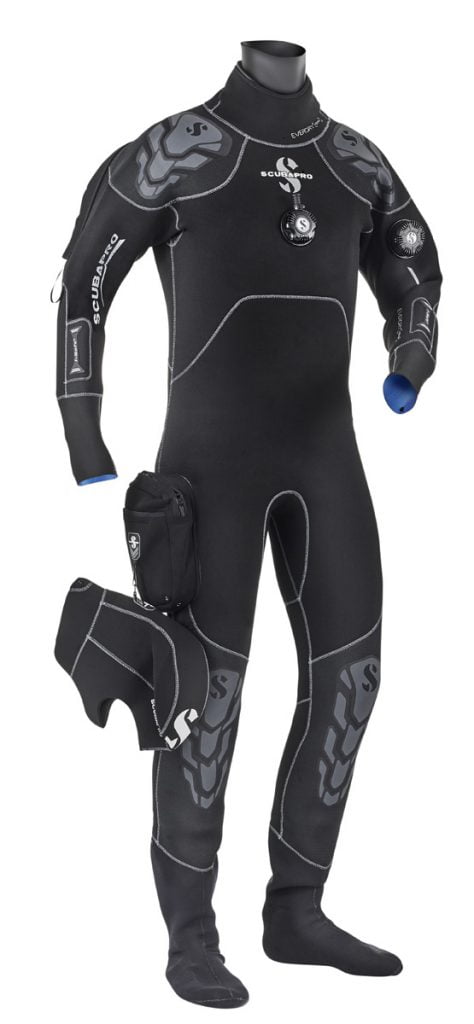
The Scubapro Everdry 4 neoprene drysuit is a cheaper option, and a great choice for a first time drysuit purchase if going to be used within recreational limits.
Features
- 4mm density neoprene
- Heavy-duty metal zip with protective cover
- Rear-entry
- Neoprene socks
- Cost-effective
Drawbacks
- Not suitable for the advanced, technical and/or demanding diver
- Neoprene seals
- Rear-entry suit
#5 – Waterproof D7 Pro ISS (Best All-Rounder Dry Suit)
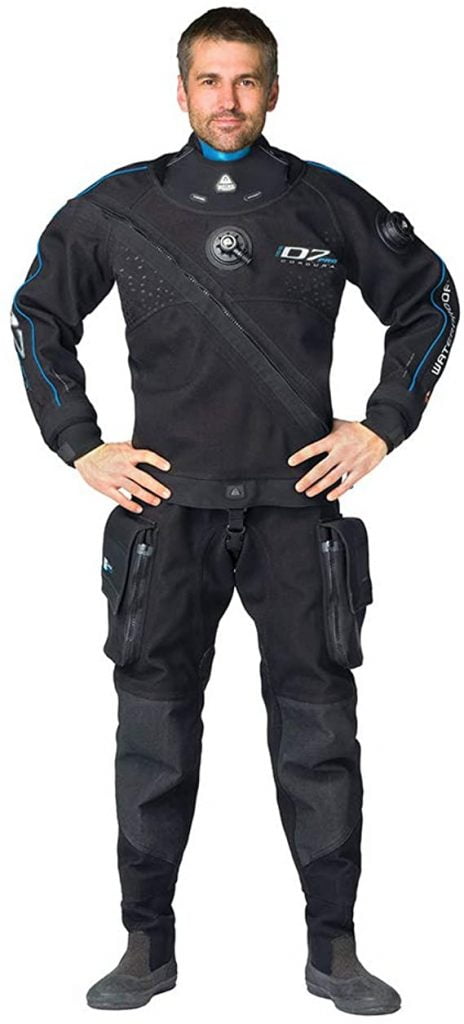
The Waterproof D7 Pro ISS is a high-end trilaminate, suitable for all levels of divers in all conditions, ranging from warm water recreational diving to sub 100 metre trimix diving. It is a fairly expensive suit, but, for the serious and/or frequent diver, it is a very worthwhile investment.
Features
- Reinforced with heavy-duty kevlar and cordura in sensitive areas
- Front-entry suit – Integrated silicone seal system (ISS) allowing quick replacement
- Telescopic torso and anatomical sculpting for snug fit with reduced excess bulk
- Dual zipper – inner metal/outer plastic, with heavy-duty protective cover
- Ability to add dry-gloves
Drawbacks
- Built-in boots instead of socks (not a major drawback, and preferred by many divers over socks anyway)
- Price
#6 – SF Tech Neoprene Classic (The Penetrator)
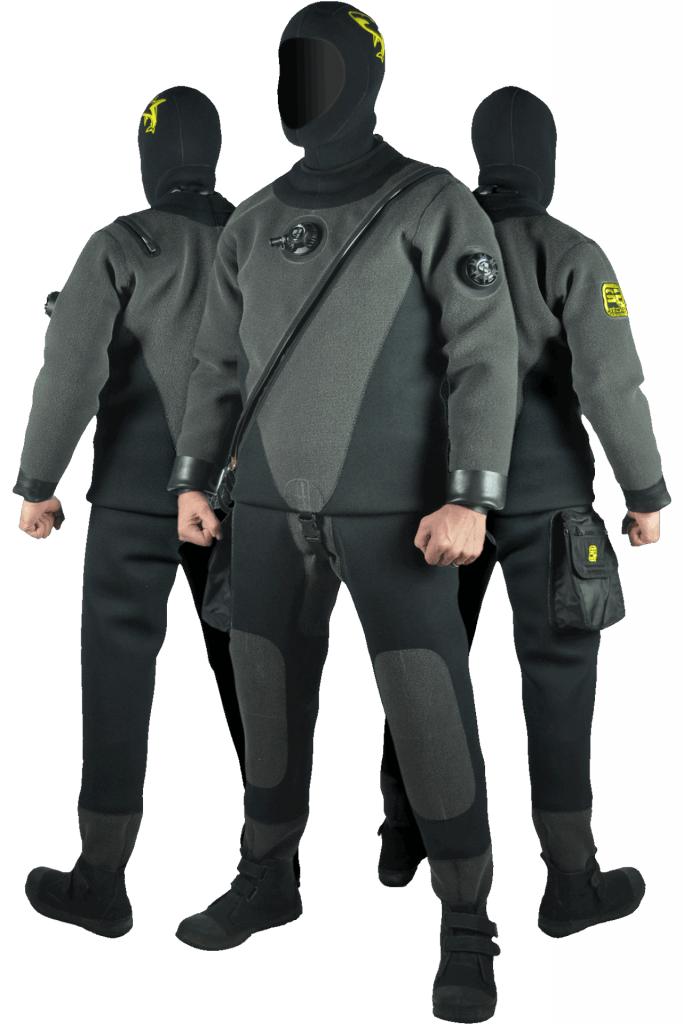
The SF Tech Neoprene Classic is an extremely tough suit made for the most demanding conditions, especially for penetration diving. The suit is made-to-measure and is fully customizable. Made with the highest quality neoprene, the diver is able to reduce their undergarments due to increased inherent insulation. Though the cost is higher than for normal neoprene suits, this is no normal neoprene suit we are dealing with.
Features
- Front entry YKK metal zipper
- Neoprene protection for the zipper
- Telescopic torso
- Heavy-duty knee pads
- Ring system – available with neoprene or latex seals (and option for dry-gloves)
Drawbacks
- Weight – 5kg (not ideal for travelling)
Frequently Asked Questions
A neoprene or a trilaminate suit?
This is, arguably, the most important consideration of all when buying the best drysuit for you. A neoprene drysuit consists of crushed or compressed neoprene which provides a degree of insulation and flexibility. Conversely, a trilaminate drysuit is effectively a dry bag for the body, and is not a means of insulation by itself. A trilaminate suit requires an undergarment in order for the diver to remain warm, whereas with a neoprene suit – environment-dependent – this is not always necessary. However, this is not necessarily a disadvantage of trilaminate drysuits (as often implied), but simply a distinct difference in function.
A pertinent consideration for those leaning toward a neoprene drysuit is that of its inherent buoyancy: neoprene floats. Although manufacturers have attempted to decrease both the buoyancy and buoyancy fluctuations of neoprene drysuits, there is yet to be a suit that does not suffer from these inherent characteristics. While the fluctuation in buoyancy characteristics is an important consideration for those wishing to dive deeper than recreational limits, the inherent positive buoyancy of neoprene is an even more crucial consideration, as it affects all divers. If you are a diver who already requires a significant amount of weight when diving wet, and are planning to dive with thick undergarments and/or in salt water and/or with aluminium cylinders, then the addition of a neoprene drysuit will only make matters worse. Minimising weight carried is an important consideration for the safety-conscious diver, and so this should be given an important role in the drysuit selection process.
Similarly, the density of neoprene makes for a heavier suit, making light-weight trilaminate suits the better choice for the travelling diver.
That said, however, the neoprene suit does have its place. On a base level, neoprene suits tend to be slightly tougher and more durable than trilaminate suits, specifically cheap trilaminate suits. A neoprene suit can take a lot more of a beating and sustain more abrasion, making it particularly good for drysuit beginners who are more likely to damage their suit without knowing. For a durable trilaminate, especially one that will withstand the toils of technical and/or cave and/or wreck diving, it will come at a substantial price. Similarly, a trilaminate suit requires much more care and maintenance, and is less forgiving in this department compared to the neoprene. This makes mid-price range neoprene suits a great option for first drysuits, as well as for recreational divers who have no wish to venture deeper than recreational limits. It also makes neoprene drysuits a great option for divers involved in more demanding environments, such as tight-wreck penetrations, who do not wish to take out a mortgage on an extra-durable trilaminate.
Rear or front-entry suit?
To a degree, this question comes down to whether or not one wishes to be the curator of their own fate. In the same way the experienced sky-diver likes to pack their own parachute, the seasoned diver tends to like to be the zipper-upper of their own suit. With a rear-entry suit, i.e. where the zipper runs shoulder to shoulder on the back of the suit, the user relies on a second person to zip and unzip them (unless they are blessed with olympic-grade flexibility and a zip waxed to the point at which it can be closed shut by a mere flick of the fingers!). Of course, this makes the user reliant on someone else for both the donning and doffing of their suit as well as for the integrity of the zipper.
Aside from this disadvantage of a rear-entry suit, there is also a greater potential for zipper damage with a back-situated zipper. Due to the rigidity of the metal zipper, when the suit is without much air inside, it has a tendency to resist bending, meaning that the mobile diver may cause excessive strain to the zipper, which can result in quicker deterioration over long-term use.
Front-entry suits have quickly become the more popular option among divers, given the ease of donning and doffing as well as the safer positioning of the zipper. That said, rear-entry suits are still common within the diving community, and are, nonetheless, very durable and popular among many divers. Ultimately, the positioning of the zipper is a choice that tends to concern more experienced drysuit divers, and is not usually of large concern to first time drysuit buyers, as it has little effect on the in-water experience.
Metal or plastic zipper?
A modern advent of drysuit technology, plastic zippers have gained popularity in recent years, with leading manufacturers, such as SANTI and Waterproof, adding YKK plastic zippers to most of their suits.
Ultimately, both types of zipper are great. The advantage the plastic zipper boasts over its counterpart is that of its user-friendly operation and the lower chance of it getting stuck in operation. However, with ample wax and consistent care, the metal zipper still remains a great feature.
For the travelling diver, the greater flexibility of the plastic zipper is beneficial, as it allows for the drysuit to be rolled up tighter and smaller without inflicting any damage. The fact that the plastic zipper is also lighter than the metal zipper confers a second advantage to the travelling diver.
Some divers speculate that plastic zippers are not as sturdy or as durable as metal zippers, but there is yet to be any sort of widespread evidence to confirm this as fact, and so, it remains as mere speculation.
Neoprene, latex or silicone seals?
Perhaps one of the more nuanced options for first-time drysuit buyers, the question of seal material is a significant consideration.
In my humble fact-based opinion, neoprene seals afford little benefit to the user compared to its sibling materials. Although neoprene seals may provide better insulation, they are more prone to leaking, and will stretch-out over time. They are also incompatible with dry-glove systems and are, therefore, unsuitable for those diving in water temperatures nearing freezing-point. They may be longer-lasting than silicone or latex as they are tougher, however, this is only a short-term benefit as replacing a neoprene seal is far harder than replacing a latex or silicone seal. The only benefit they may confer is the comfort of familiarity, in smell and feel, in an otherwise alien-feeling suit, for the drysuit newbee.
Latex provides an excellent water-tight seal, and can be trimmed down specific to user size. Latex seals are compatible with dry-glove systems, and with some latex-specific lubricant or talcum powder, are fairly easy to don and doff. Latex seals retain their shape throughout constant use, and are the toughest, most tear-resistant materials out of all the options. That said, with continued UV and ozone exposure, they will eventually wear-out. This in itself is not a disadvantage. However, the problem is that latex seals are glued in place, and require a little more time and skill to install correctly. This means that a busted seal poses a greater issue, and cannot be replaced quickly before a dive.
Conversely, silicone seals allow the user to change busted seals out and replace them with new ones in a matter of minutes, as they do not require gluing. This allows the user a lot more freedom in usage and prevents a busted seal translating to the missing of a dive. Silicone seals are also softer, easier to don and doff, and perfect for those with a latex allergy. The only downside is that silicone is slightly less puncture and tear-resistant. But, for the diver who carries spare seals, this poses little of a problem.
Built-in boots or socks?
While built-in boots provide some superficial benefits, it is – in most cases – better to go with neoprene socks.
The built-in boot is advertised with the benefit of greater durability and ease, and this is true… on a superficial level. Of course, the built-in neoprene boot is much more durable than the neoprene sock alone, and it is easy to use insofar as it requires no other external boot to be worn on top. However, the same durability can be achieved with the neoprene sock, simply with the addition of a ‘rock boot’. A rock boot is simply a boot-like normal shoe which is worn over the neoprene sock, thereby making it just as durable as its counterpart. On top of this, if the neoprene sock springs a minor leak, the user needs simply to turn the suit inside out, apply sealing glue to the inside of the sock, and the fix is done. Conversely, with built-in neoprene boots, the suit cannot be turned inside out, and so a minor leak in the boot may require greater intervention, and, in some cases, replacement of the whole boot itself.
Similarly, for the more fine-detail orientated diver, the built-in boot comes, often, with an in-water disadvantage. Due to the rigidity of the boot, it does not compress as much as the neoprene sock, leaving a greater total volume within the foot area. This allows a greater migration of air to the foot area, resulting in two outcomes. Firstly, the feet and legs will become more buoyant more frequently. Secondly, as the amount of air within the boot increases, the fine motor control involved in finning decreases, making for a sloppier technique and less in-water control. Needless to say, both of these factors can be safety hazards in the extreme. The worse the fit, especially when dealing with off-the-shelf suits, the greater the problem. Additionally, socks are again a better option for the travelling diver as they allow the suit to be rolled up tighter and smaller. They are lighter too, but this benefit is off-set by the need to carry additional rock boots.
Ultimately, however, for the first-time drysuit user, and especially for the recreational diver, whether or not the suit has socks or built-in boots is largely irrelevant, and will likely not affect the experience as much as it would for the seasoned drysuit diver. This is a preference, akin to the material of the zipper, which gains greater importance with greater experience.
Accessories?
Drysuits come with numerous optional accessories, but whether or not they are of concern to you is dependent on the type of diving you are involved in. In most cases, if you don’t know as to whether or not you need or want this accessory, then the question is probably already answered.
Dry-gloves are a necessity for very cold water; pee-valves are necessary for longer dives (in excess of 90-120 minutes) or for those for whom urinary comfort is of top priority; a telescopic-torso is a very nice addition and useful, but not strictly necessary; added cordura and/or kevlar is always a bonus, but only an important factor if the suit will be used in demanding environments where abrasion is common. Similarly, the addition of gators (velcro straps) to the shins/ankles of the suit is an effective fix for drysuits with built-in boots in which the feet continue to become buoyant.